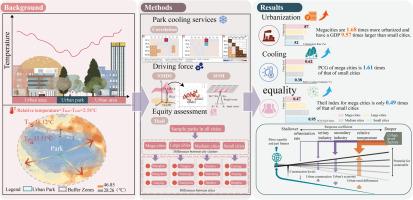City size promotes to park cooling services and equity
IF 12
1区 工程技术
Q1 CONSTRUCTION & BUILDING TECHNOLOGY
引用次数: 0
Abstract
The contribution of urban parks to enhancing thermal comfort and improving urban resilience is well-established. However, the mechanisms influencing their disproportionate cooling capacity across cities remain unclear. Therefore, understanding the factors that affect park cooling service (PCS) and its spatial equity is crucial for developing targeted urban climate risk mitigation strategies. This study evaluated the PCS and its spatial equity across 240 urban parks in 12 cities of the Yangtze River Delta, analyzing patterns along the urbanization gradient. The findings reveal that: (1) PCS is positively correlated with urbanization level, with the average park cooling service capacity (PCSC) in mega cities reaching 140 % of that in small cities (0.17 vs. 0.12). (2) spatial equity of PCSC also increases with urbanization, with mega cities exhibiting a 51 % improvement compared to small cities (0.47 vs. 0.95). (3) observed inequalities are mainly driven by industrial structure and urban–rural disparity, where relative temperature difference exerts the strongest positive effect on equity (0.23–18.00), while the share of the tertiary industry shows the strongest negative effect (−0.34 to −2.35). (4) smaller cities contain more parks with low cooling service levels (52 %) and have lower cooling area thresholds (0.56 km²), suggesting that PCS enhancement in smaller cities is more feasible. These findings provide valuable guidance for urban park planning and design to promote equity and livability across cities at different stages of urbanization.

城市规模促进了园区降温服务的公平性
城市公园对提高热舒适性和城市韧性的贡献是公认的。然而,影响它们在城市间不成比例的降温能力的机制仍不清楚。因此,了解影响公园降温服务及其空间公平性的因素对于制定有针对性的城市气候风险缓解策略至关重要。本研究对长三角12个城市240个城市公园的城市生态承载力及其空间公平性进行了评价,并分析了其在城市化梯度上的分布规律。结果表明:(1)城市公园制冷服务能力与城市化水平呈显著正相关,大城市的公园制冷服务能力(PCSC)是小城市的140%(0.17比0.12)。(2)随着城市化的发展,城市居民生活质量空间公平性也在提高,特大城市比小城市提高了51%(0.47比0.95)。(3)产业结构和城乡差异是影响城乡差异的主要因素,其中相对温差对公平的正向影响最大(0.23 ~ 18.00),而第三产业份额对公平的负向影响最大(- 0.34 ~ - 2.35)。(4)小城市的园区数量较多,制冷服务水平较低(52%),制冷面积阈值较低(0.56 km²),表明小城市的PCS增强更可行。这些发现为城市公园规划和设计提供了有价值的指导,以促进不同城市化阶段城市的公平性和宜居性。
本文章由计算机程序翻译,如有差异,请以英文原文为准。
求助全文
约1分钟内获得全文
求助全文
来源期刊

Sustainable Cities and Society
Social Sciences-Geography, Planning and Development
CiteScore
22.00
自引率
13.70%
发文量
810
审稿时长
27 days
期刊介绍:
Sustainable Cities and Society (SCS) is an international journal that focuses on fundamental and applied research to promote environmentally sustainable and socially resilient cities. The journal welcomes cross-cutting, multi-disciplinary research in various areas, including:
1. Smart cities and resilient environments;
2. Alternative/clean energy sources, energy distribution, distributed energy generation, and energy demand reduction/management;
3. Monitoring and improving air quality in built environment and cities (e.g., healthy built environment and air quality management);
4. Energy efficient, low/zero carbon, and green buildings/communities;
5. Climate change mitigation and adaptation in urban environments;
6. Green infrastructure and BMPs;
7. Environmental Footprint accounting and management;
8. Urban agriculture and forestry;
9. ICT, smart grid and intelligent infrastructure;
10. Urban design/planning, regulations, legislation, certification, economics, and policy;
11. Social aspects, impacts and resiliency of cities;
12. Behavior monitoring, analysis and change within urban communities;
13. Health monitoring and improvement;
14. Nexus issues related to sustainable cities and societies;
15. Smart city governance;
16. Decision Support Systems for trade-off and uncertainty analysis for improved management of cities and society;
17. Big data, machine learning, and artificial intelligence applications and case studies;
18. Critical infrastructure protection, including security, privacy, forensics, and reliability issues of cyber-physical systems.
19. Water footprint reduction and urban water distribution, harvesting, treatment, reuse and management;
20. Waste reduction and recycling;
21. Wastewater collection, treatment and recycling;
22. Smart, clean and healthy transportation systems and infrastructure;
 求助内容:
求助内容: 应助结果提醒方式:
应助结果提醒方式:


